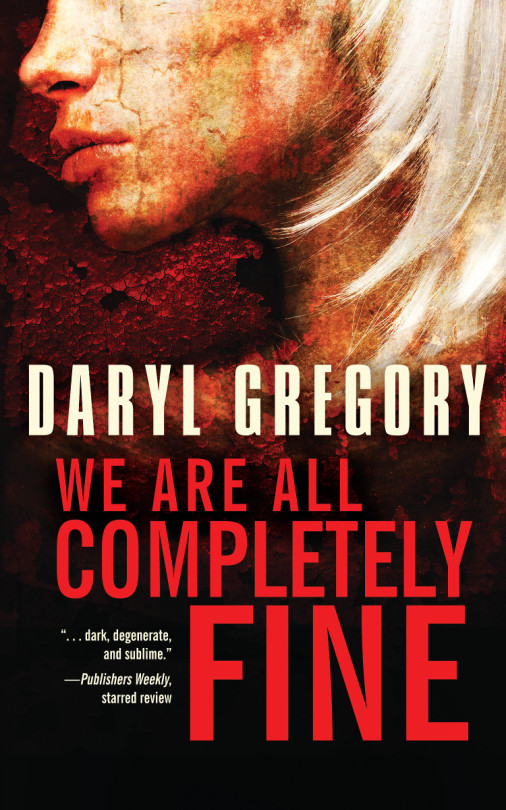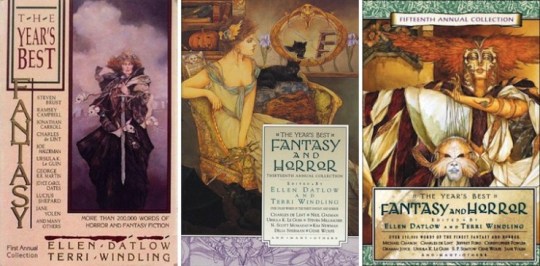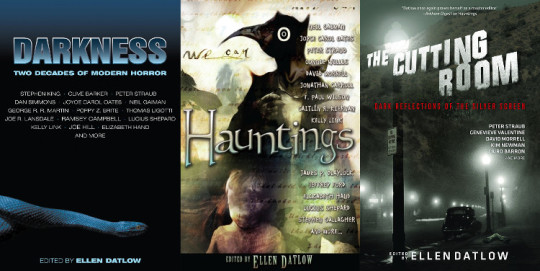Tachyon tidbits featuring Daryl Gregory, Ellen Datlow, Peter S. Beagle, and Charlie Jane Anders
The latest reviews and mentions of Tachyon titles and authors from around the web.

Daryl Gregory, Ellen Datlow, Peter S. Beagle (photo: Paul Todisco), and Charlie Jane Anders(Tristan Crane)
At UNBOUND WORLDS, Matt Staggs includes Daryl Gregory’s award-winning WE ARE ALL COMPLETELY FINE in 10 Sci-Fi and Fantasy Novels Featuring Characters Living with Mental Illness.
The last survivor of a cannibal attack, a traumatized supernatural detective, a person who can see spirits, whether they want to or not. They all survived brushes with supernatural horrors, and now they’ve formed a support group. Will talking about their experiences help them heal, or summon their tormenters for another dose of terror?

Amber Troska for TOR.COM appreciates Terri Windling and Ellen Datlow.
It is difficult to overestimate the tremendous value of editors. The contributions that authors make to their respective fields, and their impact on the readers that encounter their work, can’t be overstated either, of course—but it is equally important to remember that no truly great author goes it alone; there are always strong editors behind the scenes, shaping the individual stories themselves as well as the publishing world at large. The Hugo Awards are named for an editor, after all.
Yet I can count most of the editors I recognize by name on one hand. Even with such a limited group to choose from, only two have had an extremely significant, identifiable impact on me as a reader: Terri Windling and Ellen Datlow. I could never hope to cover everything the two have contributed to the publishing world—their careers have stretched too far and are too varied and far-reaching for me to do them full justice. However, there are several projects that are worth looking at in order to appreciate their impact and get a sense of how influential their work has been, and continues to be.
Windling and Datlow have had an editorial partnership spanning over three decades, and their names, for me at least, have stood as markers of quality for much of my reading life. From the time I first discovered their Year’s Best anthologies, I have looked to them as arbiters of the very best in genre storytelling. Now, it’s quite possible that I’m making a gross generalization based on my own limited experience (it’s been known to happen) but, despite winning several prestigious awards, Datlow and Windling are quite possibly two of the most recognizable editorial names in modern fantasy and horror, and yet I see little aside from a few occasional interviews that give them the credit they deserve. Jeff and Ann VanderMeer might be giving them a run for their money in the coming years for the title of Most Famous Editing Pair in Speculative Fiction, but Datlow and Windling have a significant head start on their side.

In terms of their partnership, each editor has a specialty—Ellen Datlow focuses more on horror while Terri Windling’s wheelhouse is fantasy—yet rather than simply taking a divide-and-conquer approach, their work illuminates and explores the relationship between fantasy and horror. Fantasy and science fiction are so often and automatically lumped together that it can be easy to overlook how much DNA fantasy and horror really share…something that becomes even clearer when you look at another anthology series the two produced, beginning with Snow White, Blood Red in 1993.
Anyone with even a passing interest in fairy tales knows that many of the versions we encounter today have been sanitized over the years and rebranded as children’s stories. Disney has become the most famous bowdlerizer of fairy tales, but the genre in general has been steadily transformed since the 19th century—something Terri Windling highlights at the start of her introduction to Snow White, Blood Red. In that intro, she makes clear that the intent of the collection (and eventual series) she and Datlow had undertaken is not to simply update old stories with modern flourishes but to recapture the original darkness of fairy tales, bringing them back to the adult audience that has forgotten their once-considerable power. As with the Year’s Best anthologies, Datlow and Windling focus on their respective areas of genre expertise. Unlike those broader anthologies, however, the fairy tale collections don’t ever feel like the two separate genres are sitting side-by-side, but are united in one vision, despite the deliberate split in the title (a convention that carries through the rest of the series).

Richard Parks on his eponymous site apologizes for Peter S. Beagle’s IN CALABRIA.
All right, I’ll cut right to it–I had planned to have a review of Peter S. Beagle’s IN CALABRIA (Tachyon, February 2017) before now. That the book is over a year old is as good an example as any of how useless I am to anyone as a review blogger, which makes me no never mind since that was never my intention here in the first place. Once I reviewed for magazines with deadlines and everything and I never missed one, but then I was usually getting paid for it. Now I pay for my own books, I review what I want to when I want to, thanks very much, and that’s all there is to it.
Ahem. Slight digression there. Regardless, I’m not ready to review the book because I’m not through reading it. That’s taking a while, and not because it’s a doorstop. It is definitely not. It’s a slim volume beautifully produced by Tachyon Publications, lovely to look at, and at first glance the sort of thing any halfway decent reader could tear through in an afternoon. So could I, if it was a book by almost anyone other than Peter Beagle. So some of you might understand that I am going slowly, savoring, and am in no bloody hurry to finish.
Another reason is that I always–always–approach Beagle’s work with a bit of caution, if not trepidation. Peter Beagle is never a light read, and I never come to it lightly. I understand that I might have my heart ripped out; it’s a risk that comes with anything of emotional depth and utter truth. I’m embarrassed to say how long it took me to get to his THE INNKEEPER’S SONG, but in my defense I did so, but long after any such review would have served either the author or the publisher’s interest nearly as much as something less reverent but more relevant and–most important–timely might have. I’ll have to give my regrets in advance here, too.

LOCUS reports that Charlie Jane Anders will be joining LeVar Burton Reads LIVE! at the Palace of Fine Arts in San Francisco on April 29.
For info on WE ARE ALL COMPLETELY FINE, visit the Tachyon page.
Cover design by Elizabeth Story
For more info about DARKNESS: TWO DECADES OF MODERN HORROR, visit the Tachyon page.
Cover by Ann Monn
For more info about HAUNTINGS, visit the Tachyon page.
Cover art “Voice of Shades” © 2010 by Valentina Brostean
For more info about THE CUTTING ROOM: DARK REFLECTIONS OF THE SILVER SCREEN, visit the Tachyon page.
Cover by Josh Beatman
For more info about IN CALABRIA, visit the Tachyon page.
Cover design by Elizabeth Story
